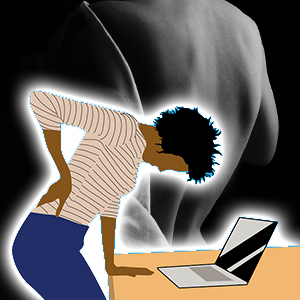Upper Back Pain and Sciatica Helped with Chiropractic Care
The Annals of Vertebral Subluxation Research published the results of a case study on January 16, 2024, documenting the improvement, under chiropractic care, of a patient with scoliosis who was suffering with upper back pain and sciatica.
 Scoliosis
is a lateral curvature of the spine when viewed on a front
or back x-ray. In many cases, scoliosis was present as an
adolescent but went undiagnosed if not accompanied by pain.
Common medical treatment for scoliosis where the curvature
is not too severe involves addressing any pain. This
commonly means pain medications or anti-inflammatory drugs.
Medical treatment may also involve physical therapy.
Scoliosis
is a lateral curvature of the spine when viewed on a front
or back x-ray. In many cases, scoliosis was present as an
adolescent but went undiagnosed if not accompanied by pain.
Common medical treatment for scoliosis where the curvature
is not too severe involves addressing any pain. This
commonly means pain medications or anti-inflammatory drugs.
Medical treatment may also involve physical therapy.
In this case, a 30-year-old woman presented herself for chiropractic care. The woman stated that she had been suffering with upper back pain and sciatica for more than 10 years. She rated her upper back pain as an 8 out of 10, with 10 being the worst. She also reported that her sciatic pain, which she rated as a 7 out of 10, affected her daily life. She noted that the severe pain interfered with her ability to do regular daily activities such as bending, driving, household chores, lifting, or just standing.
A chiropractic examination was performed which included spinal palpation, range of motion, postural analysis, and some orthopedic testing. Spinal x-rays were also taken. The study reports that the x-rays showed the presence of scoliosis along with spinal subluxations.
Specific forms of chiropractic adjustments were started to address the subluxations found on the examination. The author noted, "The aim of this chiropractic care was to decrease vertebral subluxation findings, decrease upper back pain and sciatica as well as to improve the patientís activities of daily living."
The study author explains the chiropractic approach to helping people with pain from scoliosis by saying, "The curvature and rotation of the vertebrae in cases of scoliosis can be due in part to vertebral subluxation and can contribute to the symptoms of subluxation. Subluxation is caused by the rotation of a vertebra compared to the segment below. It can cause functional and structural changes that affect neural integrity and may negatively impact overall health. Symptoms such as back pain and sciatica may be associated with the presence of subluxation in a patient."
By the time of the patientís first re-examination, her upper back pain had reduced to 4 out of 10, and her sciatic pain had decreased to just 2 out of 10. As care continued, the woman continued to see improvement. Eventually she reported that she no longer had sciatic pain, and her upper back pain was only present at a level of 2 out of 10.
In addition to pain relief, the improvement the woman experienced had a profound effect on her quality of life. The study reported, "The correction of vertebral subluxation was successful in reducing her current pain level and improving her cervical and lumbar ranges of motion. The patient stated that prior to starting care, she was scared to consider trying to start a family for fear of the physical toll that it would take on her body. Following her care, she felt that she would be able to do so and to continue under care during her future pregnancy as well."
The study author summed up this case by saying, "Initially, this patient was dealing with daily pain in her upper back as well as daily sciatica down her right leg. Both of these issues had been present for more than 10 years. After having unsuccessful physical therapy, she felt that chiropractic care could be an option for her. She was able to perform her activities of daily living in a pain-free way and felt more optimistic about her familyís future following the delivery of chiropractic care."
 In
this case, a 27-year-old man went to the chiropractor for
his lower back pain along with numbness in the left thigh.
Five years earlier, the man had gone to a surgeon for his
back pain. The surgeon recommended and performed surgery to
add an instrument to increase space between the young manís
lower lumbar discs. The history records that the manís pain
got much worse, so a second surgery was performed to remove
the instrument. Since then, the man has suffered with worse
than his original lower back pain which he rated as between
a 6 and 7 out of ten, with 10 being the worst. The study
reports that the original records about the manís surgery
were unavailable because the surgeon was incarcerated.
In
this case, a 27-year-old man went to the chiropractor for
his lower back pain along with numbness in the left thigh.
Five years earlier, the man had gone to a surgeon for his
back pain. The surgeon recommended and performed surgery to
add an instrument to increase space between the young manís
lower lumbar discs. The history records that the manís pain
got much worse, so a second surgery was performed to remove
the instrument. Since then, the man has suffered with worse
than his original lower back pain which he rated as between
a 6 and 7 out of ten, with 10 being the worst. The study
reports that the original records about the manís surgery
were unavailable because the surgeon was incarcerated. As
bad as the problem of chronic pain is, this study documents a
patient who suffered from chronic pain for 48 years before
receiving chiropractic care. In this case, a 60-year-old man
presented himself at a chiropractic office. His history revealed
that at age 12 he was injured while lifting hay bales on a farm.
For years, he treated the pain by taking over-the-counter (OTC)
medications, such as ibuprofen and acetaminophen. Eventually,
the OTC medications stopped giving any relief and the man was
developing GI problems from continually taking these
medications.
As
bad as the problem of chronic pain is, this study documents a
patient who suffered from chronic pain for 48 years before
receiving chiropractic care. In this case, a 60-year-old man
presented himself at a chiropractic office. His history revealed
that at age 12 he was injured while lifting hay bales on a farm.
For years, he treated the pain by taking over-the-counter (OTC)
medications, such as ibuprofen and acetaminophen. Eventually,
the OTC medications stopped giving any relief and the man was
developing GI problems from continually taking these
medications.  This
study begins by referencing a previous study on tonsillitis
and chiropractic care. "A study conducted in England in 1991
revealed significant findings regarding the treatment of
tonsillitis in children. When twenty-seven children received
adjustments, twenty-five experienced complete relief from
their symptoms." The study suggests a link between
subluxations and the susceptibility of tonsilitis
infections.
This
study begins by referencing a previous study on tonsillitis
and chiropractic care. "A study conducted in England in 1991
revealed significant findings regarding the treatment of
tonsillitis in children. When twenty-seven children received
adjustments, twenty-five experienced complete relief from
their symptoms." The study suggests a link between
subluxations and the susceptibility of tonsilitis
infections.